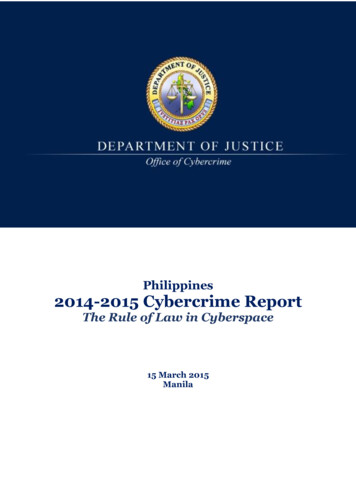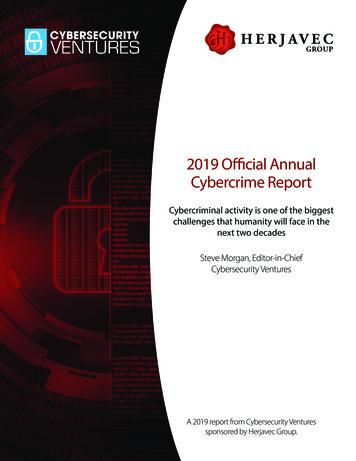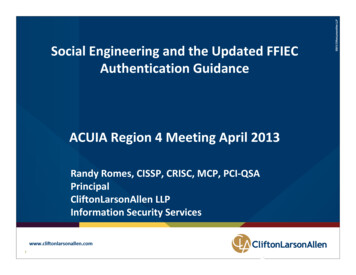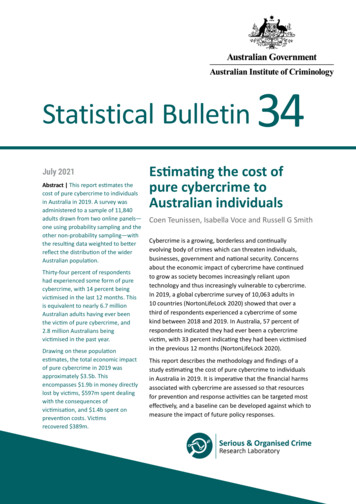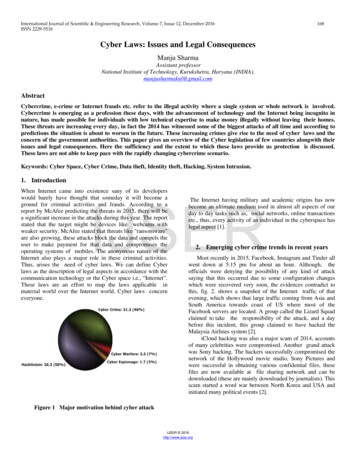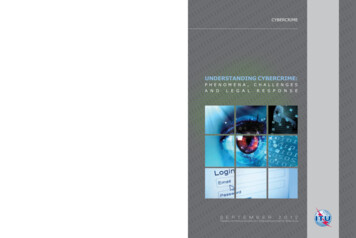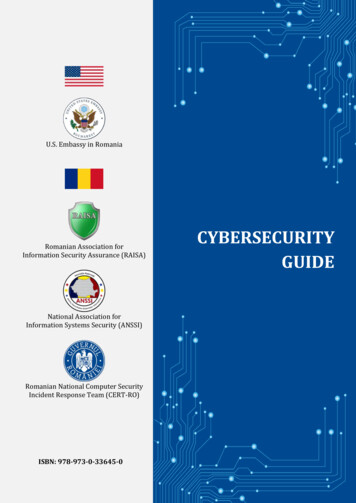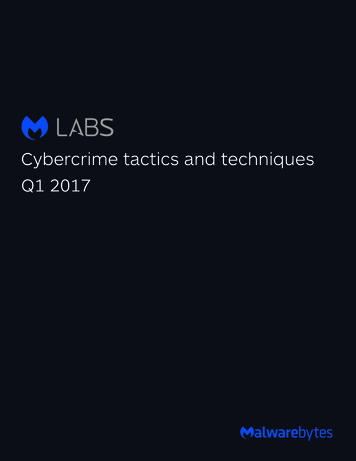
Transcription
Cybercrime tactics and techniquesQ1 2017
TABLE OF CONTENTS01Executive summary02Windows malware02Ransomware trends04Cerber, king of ransomware05Ransomware as a service05New evasion features06Where did Locky go?06Keep an eye on Spora and Sage07Windows malware predictions08Mac malware09Mac predictions09Android malware11Android predictions11Distribution methods11Exploit kits13Malicious spam14Scams14Social media scams14Social media scams predictions15Tech support scams15Tech support scam predictions16Research spotlight: Chris Boyd17Conclusion18Contributors
IntroductionThe first quarter of 2017 brought with it some significant changes to the threat landscape, and we aren’t talking aboutheavy ransomware distribution either. Threats that were previously believed to be serious contenders this year havenearly vanished entirely, while new threats and infection techniques have forced the security community to reconsidercollection and analysis efforts.In our second Cybercrime Tactics and Techniques report, we are going to take a deep look at which threats got ourattention the most during the first three months of the year. In addition to that, we are also going to be providingpredictions on what the second quarter of 2017 might look like. We are also going to give you a peek behind the scenesof Malwarebytes Labs, at the analysts who make reports like this possible.Executive summaryThe Cerber ransomware family took the mantle as topIn malware distribution news, RIG exploit kit continues toransomware by market share in the first quarter ofreign supreme; however, a lack of new exploits, features,2017, leaving all competitors in its dust. In addition to itsor competition means that it’s only a matter of timecontinued use of the Ransomware as a Service model,until RIG is dethroned. Otherwise, distribution continuesnew advancements made to the malware’s functionalityheavily through malicious spam. An increase in socialmean that it’s unlikely we will see a decrease in the useengineering tactics used by both exploits and malspamand spread of Cerber in coming months. At the sameto avoid sandbox analysis and add credibility to thetime, our prediction that Locky would continue to be aattacks means that you can in fact teach an old dog newmajor player in the ransomware market was completelytricks.wrong, since by the end of March, it has all but vanished.However, a few new players entering the market appearOn the scam front, the leak of notable WWE stars’very promising and might make a bigger splash later inprivate images has been co-opted by survey scammersthe year.to spread fake links through social media. Alternatively,tech support scammers have been observed takingOn the Mac side, a surge of new malware and backdoorsgift cards as payment and using social media to scam plagued the community this quarter, including anotherother scammers. They do this by offering out-of-the-Mac-focused ransomware and numerous infiltrations ofbox tech scammer packages that fail to live up to theirPotentially Unwanted Programs (PUPs) in the Apple appadvertisements entirely.store. This trend of spreading PUPs through legitimatesources is unlikely to change based on Apple’s behaviorWith the chaotic and dynamic nature of the cybercrimein the past, which has tended toward avoiding removingworld, especially as observed over the last six months,PUPs.we can expect a very interesting year and predict someserious changes with ransomware distribution andTwo notable Android threats have been causing a lot ofmarket share by the end of the summer.trouble, one of them acting as a ransomware, utilizingAndroid administrative security features against users,while the other locks the system to ensure continued adrevenue coming from the app. We expect both threatsto continue being a problem throughout next quarter.Cybercrime tactics and techniques Q1 20171
Windows malwareThe first few months of 2017 revealed much of the same trends we observed moving out of 2016 when it comes toWindows malware—basically, lots of ransomware sprinkled with some ad fraud and just a pinch of everything else.This observation is confirmed by the chart below, which shows malware distribution by malware type for the first threemonths of 2017.Figure 1. Malware distribution by typeQ1 2017As you can see, ransomware continuesto be the most heavily utilized type ofmalware by the most popular methods ofdistribution, both exploit kits and maliciousspam (malspam). As such, we are going todelve into this trend even deeper in our firstsection of this report.Ransomware trendsIf you caught our last Cybercrime Tactics and Techniques report for 2016, we talked about the two contenders for kingof ransomware: Locky and Cerber. So far in 2017, we’ve seen a massive shift in the battle between these two families,with Locky basically dropping out entirely and Cerber expanding its market share by a significant amount.Figure 2. 12-Month ransomware familytrends 2016/2017The above chart expresses Cerber’scomplete rise, especially noticeable whencompared to other ransomware families overthe last 12 months. Not only does it showCerber reaching market share domination onpar with TeslaCrypt during its most populartimeframe (the first half of 2016) but also thequick fall of the very promising Locky family,which we will discuss in more detail later.2Cybercrime tactics and techniques Q1 2017
Stepping away from analysis of ransomware family statistics obtained from distribution sources (i.e. Malwarebytescontrolled honeypots) we look at what our users are dealing with. The below graph charts the top 20 most heavilydetected ransomware families of the first quarter of 2017.Figure 3. Ransomware Top 20families, Q1 2017Once again, Cerber not onlysticks out as number 1 against allother families, but it completelytowers over subsequently rankedransomware families, such as thequickly vanishing Locky.Figure 4. Ransomware familypercentage, Q1 2017Next, we take a deeper look atjust Q1 2017 ransomware familydistribution, where Cerber starts offthe year with a 70 percent marketshare and approaches 90 percenttoward the end of the quarter.Cybercrime tactics and techniques Q1 20173
In order to give some attention to the families that live in Cerber’s shadow, we drilled down into the next five top familieswe observed being dropped. From this view, the fall of Locky is very apparent, with it dropping to under 2 percent marketshare by the end of March.Figure 5. Ransomware family percentage(drill down), Q1 2017This chart does show an interesting newdevelopment, with brand-new familieslike Spora and Sage making a small (butsignificant) appearance during the firstquarter. We might see more from atleast one of these families in Q2 2017;however, based on the slight decrease inthe distribution of these families duringMarch, it’s just as likely they will vanishinto obscurity in the next few months.Cerber, king of ransomwareIf you read our last report, you know that we considered it a possibility that Locky and Cerber would continue their tugof-war for distribution market share through Q1 2017. Unfortunately, we were wrong. However, this situation acts as aperfect example of how dynamic and sensitive the cybercrime world is.Figure 6. Cerber ransomware lock screenJust like TeslaCrypt, Cerber has risento the top of the ransomware market,leaving all competitors in its dust. Again,like TeslaCrypt, Cerber can just as easilybecome yesterday’s news. However, thereare a few factors at play with Cerber thatcould make its future different than thatof families like TeslaCrypt and Locky.4Cybercrime tactics and techniques Q1 2017
Ransomware as a ServiceNew evasion featuresSoftware as a service and security as a service areYou can’t expect to stay on top if you aren’t willing toterms that describe a business/development modeladapt and evolve, which is why Cerber has recentlythat is frequently used in the technology industry. Thestarted employing some new tricks, mainly for the saketerm refers to software or the deployment of securityof avoiding detection by security vendors.solutions or even storage “on-demand” or “as a service.”The security vendor Trend Micro recently released itsThe “as a service” model is very popular with the largeranalysis of a new Cerber variant that not only attemptsInternet companies, and you probably interact withto evade antivirus solutions that employ machineit on a regular basis if you use Google Apps (Sheets,learning, but also detects if the malware is executingMail, Drive) or the Amazon Web Service (AWS). So it’swithin a sandbox or virtual machine.no big surprise that the bad guys thought it would be aneat way to do business as well, which brings us to theBasically, this version of Cerber is distributed viaRansomware as a Service (RaaS) model.phishing emails. These emails include a link to a Dropboxfolder to download a self-extracting archive file thatCerber is a RaaS, and its spread is largely becausehas three files inside, each one individually not verythe creators have not only developed a superiordangerous, but designed to work together to executeransomware with military-grade encryption, offlineCerber functionality. The process works like this:encrypting, and a slew of new features (which we willdiscuss later), but by also making it very easy for nontechnical criminals to get their hands on a customizedversion of the ransomware.Figure 8. Cerber’s new detection evasion1.The phishing email includes a link to download aself-extracting executable from Dropbox.2.Figure 7. Ransomware as a Service model. Developerssell to affiliates and take a cut of the ransom.3.Once the ransomware is purchased, options existfrom other parts of the cybercrime marketplacethat will distribute the malware through numerousmeans, ensuring the greatest amount of infection.4.program used by advertisers.A Visual Basic Script fileb.A library (DLL) filec.A binaryThe VB script executes RunDLL32.exe and loads theThe DLL reads the binary file and decrypts themalicious code inside.5.The decrypted code acts as a loader that checksto see if the victim system is a virtual machine andlooks for numerous analysis tools and securityfranchised the ransomware get paid, but the Cerberrecognize this process as being akin to an affiliatea.DLL into memory.Once infection and payment occur, the criminals whodevelopers also get a cut of the ransom. You mightThe executable extracts and drops three files:products (to evade automated analysis).6.Finally, the loader code injects Cerber code intoone of a few possible running processes and startsencrypting user files.Cybercrime tactics and techniques Q1 20175
So, what does this mean for stopping Cerber infectionsNecurs switched to pushing different malwarein the future? Basically, software that uses machineThe Necurs botnet, which is responsible for a lot of thelearning to identify malicious features present inphishing attacks and malicious spam used to distributepreviously unseen (or zero-hour) malware may missmalware over the years, seems to no longer be pushingidentifying any of the individual parts of this newLocky ransomware. Security researchers noticed in Junevariant of Cerber. Fortunately, many security companiesof last year that when Necurs went down temporarily,(including Malwarebytes) don’t put all their eggs in onenumbers for Locky also dropped.basket and prevent threats at numerous phases of theattack chain. While Cerber may have found a loopholeSince the beginning of the year, researchers have stillin physical binary detection, memory monitoring,observed Necurs spam. However, it seems like they aredistribution prevention, and behavioral heuristics shouldgoing in a different direction and have dropped Locky asstill do the trick.a primary payload.No new Locky versionsWhere did Locky go?As mentioned previously, the biggest revelation ofQ1 2017 as far as malware market share goes is thedisappearance of Locky. Over the course of the firstthree months of 2017, Locky went from nearly a 70percent market share to 12 percent in January, and byMarch it had less than 2 percent.The reason behind why Locky suddenly vanished isanyone’s guess—the security industry overall has notdiscovered a true reason. However, there are a fewtheories.While not necessarily a different theory from the above,the InfoSec world has noticed a lack of new Lockyversions since the beginning of the year, which meanseither the group behind this heinous ransomware hasdecided to move on to different business opportunities,or they were caught by law enforcement (or worse).Either way, we should all be thankful that one of themost dangerous families of ransomware seems to havevanished for the time being. We do still need to worryabout an overpowered and heavily distributed Cerber,though, so don’t let your guard down just yet. Also, justbecause Locky seems to be a thing of the past nowdoesn’t ensure that it won’t be back in a few months.Keep an eye on Spora and SageThe last Windows malware information we want to cover involves two families of ransomware that are beefy in theirdesign but have yet to make a big impact through distribution channels: Spora and Sage.Figure 9. Spora, Sage, and CerberSPORASAGECERBERENCRYPTION ALGORITHMAESElliptic Curves /ChaCha20AESOFFLINE ENCRYPTINGYesYesYesDECRYPTOR AVAILABLENoNoNoTOR PAYMENT SITEYesYesYescomparisonsSage, Spora, and Cerber all have a lotin common as far as their encryptioncapabilities and stand-alone encryptionmodels. However, while Sage seems tobe your run-of-the-mill ransomware,secure in its encryption but otherwiseuninteresting, Spora has decided toset itself apart with superior customerservice for its victims.6Cybercrime tactics and techniques Q1 2017
Windows malware predictionsIt has clearly been a very busy quarter for Windowsmalware, with some families vanishing, others startingto make an impact, and, overall, a complete takeover ofCerber ransomware. So, what are we going to see nextquarter?Cerber is going to continue to be a massive force in theransomware world. Since the creators of Cerber continueto develop and sell the ransomware to affiliates, it wouldlikely take interaction from law enforcement to haltoperations and shut the ransomware down. However,Figure 10. Spora lock screenbarring a huge mistake from one of the group membersthat gives some hint as to their identities, it’s unlikelythis malware will vanish before the end of Q2.The Spora payment site provides a lot of featuresnot frequently seen being used by other ransomwarefamilies: Immunity from future infections Per-file restoration Live customer service chatSage and Spora had a fair amount of distributionattention in February of 2017, with a slight drop inMarch, but we will have to wait and see if that trendcontinues or if we can see one of them going head-tohead with Cerber by the end of Q2.Spora is going to take greater market share. Becauseof its secure design and professional payment site,Spora could very likely bring in a lot of profit from itsoperations, which could in turn be invested into greaterdistribution campaigns. However, catching up withCerber is no easy feat, so we expect Spora to obtaingreater market share over other families but remain farbehind Cerber.Finally, we didn’t really mention Windows malware thatisn’t ransomware in this quarter’s report. However, theKovter Trojan has continued to be the most heavilynon-ransomware malware distributed through regularchannels. We predict a continuation of its operationsthrough Q2, though we are expecting some changes toeither the malware’s purpose, function, or distributionvery soon. Any modifications made to the Kovtercampaign is unlikely going to be beneficial to its victims.Cybercrime tactics and techniques Q1 20177
Mac malwareThe first quarter of 2017 has seen quite a few newMac PUPspieces of Mac malware, nearly equaling the number thatPotentially Unwanted Programs (PUPs) in the Mac Appappeared in all of 2016. Most these threats have beenStore have become a serious problem. As an example,backdoors, varying in capability, delivery method, andsearching for “adware” on the store will result in a list ofsophistication. Even backdoors delivered via Microsoftsupposed adware or malware removal apps, and a veryOffice macros have seen a resurgence on the Mac,large percentage of them are either junk or scams. Weinstalling various backdoor components.have reported many of these to Apple, but most havenot been removed.BackdoorsThese backdoors have varying capabilities, but generallyWe recommend taking care about what you downloadinclude most or all of “the basics”: the ability to runfrom the Mac App Store, especially when it comes toarbitrary shell commands, download and install files,antivirus or anti-adware software, which is difficultexfiltrate files from the infected system, stream datafor most people to verify the effectiveness of. (Fewfrom the webcam, and log keystrokes. Some have morepeople have a ready supply of malware and adware tospecific capabilities, such as capturing password datatest with!) Also avoid any kind of system or memoryfrom the keychain or searching out and exfiltrating“cleaning” apps.backups of iOS devices.FindZipOnly one threat varied from the backdoor trend, and thatwas the second-ever ransomware to appear on the Mac(the first one being KeRanger, which appeared in Marchof 2016). This quarter’s new ransomware, called FindZip,was a rather unsophisticated attempt that didn’t evengive the hacker behind it the capability to decrypt files.Figure 12. Adware results on the Mac App StoreFigure 11. FindZip ransom noteFindZip was found on a piracy site, pretending to be a“crack” for apps like Adobe Premiere Pro or MicrosoftOffice. To date, the bitcoin wallet meant to collectransom for this malware has received no paymentswhatsoever.8Cybercrime tactics and techniques Q1 2017
Phishing has been a problem for iCloud accounts.Mac predictionsCommon phishing emails have included supposedWe anticipate seeing more Mac malware the rest of thisnotices from Apple that an iCloud account has beenyear, most likely leading to a spike in malware largerlocked, requests to confirm an iCloud account, orthan any year since 2012, the most active year in Macinvoices for a purchase from iTunes or the App Store.malware. This year could even surpass 2012 if currentSuch emails contain links that go to look-alike Appletrends continue for the rest of the year.login pages.We also predict seeing an increasing problem with PUPsSome of these email messages and phishing sites arein the Mac App Store, due to Apple’s reluctance to act onquite convincing, so it’s very important to pay closesuch apps. PUP developers have been emboldened byattention and never click the links in these messages. Tothis and seem to be swarming to the store in increasingmanage your Apple ID, go directly to appleid.apple.com,numbers.and to view purchases in iTunes or the App Store, usethe appropriate features within those apps.Targeted malspam has primarily been a Windowsproblem to date, but the reemergence of Microsoft OfficeVault 7Much ado has been made about WikiLeaks’ releaseabout CIA malware for the Mac as part of its Vault 7leak. None of those tools turned out to be able to infectany modern Macs, as they abused vulnerabilities thathad been patched years before, and some only appliedto very old hardware. There was nothing particularlysurprising or concerning in the leak.macro malware capable of affecting Macs may changethis. Many of these malicious documents include codethat is capable of detecting whether it is running on aWindows or Mac system and taking action appropriateto the system to infect it. This means that malspam willno longer be an issue only of concern to Windows users,and Mac users will need to be increasingly wary of emailattachments.Android malwareIf you’ve read end-of-year summaries from otherin between game levels. During the first quarter ofsecurity vendors in the past, you know that predicting2017, we saw an explosion in a new way of advertising:additional Android infections is a common theme.blocking the removal of an overly advertised app. InYear after year, however, these predictions generallycomes Trojan.HiddenAds.lck, currently the biggestdon’t come true. Despite that, we would be remiss ifoffender of this behavior. There have been thousandswe did not talk about two malware families currentlyof these samples littered across the Android landscape,plaguing Android users, especially since they both takeeven being found in the Google Play Store. Many comeadvantage of administrative security features.bundled with seven or more adware libraries.Trojan.HiddenAds.lckBlocking the removal of an app on Android is not a newWhen it comes to advertising, most Android users aretolerant and will accept some form of advertising, butadvertisers and developers can be greedy and will ruinthe mobile experience. A few years back, there werea handful of aggressive advertising offenders. Nowconcept—it was made famous by various ransomwarefamilies—but to have this done by seemingly ordinaryapps is very interesting. Like most Android malware,the malware author uses Android features against theunsuspecting victim, in this case “Device Administrator.”it’s rampant, from full-screen ads to 15-second videosCybercrime tactics and techniques Q1 20179
Figure 15. HiddenAds.lck lock screen codeFigure 13. HiddenAds.lck in actionOften the victim can remove HiddenAds.lck and similarlybehaving apps by restarting the device in Safe ModeWith the rise of the Bring Your Own Device (BYOD)dilemma, Google introduced device administration togive Enterprise app developers added security control.Apps can implement device policies such as passwordsettings, remote wipe, and locking the device. The onebig problem with this is that it is available to all Androidapp developers, and the bad guys have found a way toabuse it. Most Android users are unaware of the powerthis setting has, so they blindly accept any app requestto be added to the list of device administrators.In HiddenAds.lck’s case, it uses the “lock device” policyto prevent itself from being uninstalled. The implantationis rather simple: Request Device Administrator privilege Add logic to wait for an attempt to deactivate theand removing the app from device administrationaccess. Other times, there are more advanced stepsneeded. Not many Android users even realize there is aSafe Mode on Android, but it is there and can help savethe day. Check with your device manufacturer on thebutton sequence to restart into Safe Mode.Ransom.JisutJisut is an Android ransomware that has continued tooutpace other ransomware with new sample output. Theprevious quarter saw a huge increase in Jisut samples,and the first quarter of 2017 did not disappoint, withtens of thousands of new samples being introduced intothe wild.app from Device Administrator Lock deviceFigure 14. HiddenAds.lck lock access codeThis creates a cycle of events where the victim cannotuninstall the offending app, which equals continued adFigure 16. Jisut-infected APKs discovered Octoberrevenue.2016–March 201710Cybercrime tactics and techniques Q1 2017
The Jisut ransomware can act as a stand-alone app orAndroid predictionsjust infect a legitimate app with the Jisut payload orFor this next quarter, we don’t expect to see any newthe ransom logic embedded. Like HiddenAds.lck, Jisutand innovative malware on Android, but we do expectalso uses device administration against the user. Theto see a lot of the same. Jisut will continue to churntactic of this threat is to reset the password or PIN codeout new samples, the distribution model appears to befor the lock screen. If changing these access codes isworking, and they are able to get new infected apps outsuccessful, the malware can threaten the victim with thequickly.encryption of files, demanding a ransom for access.There will likely be another infestation of HiddenAdsAs you can see with these two examples, there is a fineintroduced into the Google Play Store, disguising in-appline between what the developers of grayware and thoseadvertising as the way to go when trying to evade theof ransomware do: they prevent users from removingnotice of Google as well as Android security companies.malicious apps and use the device as a revenue maker.Distribution methodsThe first part of 2017 brought much of the sametrends as far as malware distribution mechanisms go,with exploit kits taking a back seat to malicious spam.However, the quarter did bring a few new developmentsin the form of greater social engineering tactics addedto previously effective methods of infection.Exploit kitsIn Q1 2017, exploit kit activity remained low, with evenfewer antagonists than in the past quarter. In particular,RIG EK has continued to serve the Cerber ransomwarevia compromised websites and malvertising campaigns.The lack of new exploits has led to an increase in socialengineering to infect users, especially if they are runningFigure 17. HoeflerText font scam, spreading Sporaa different browser than Internet Explorer. Trafficdistributors will triage potential victims upstream andchoose to redirect them to an exploit kit (if they arepotentially vulnerable) or to a fake page with the samegoal of delivering malware.It’s interesting to note that stale exploits are becomingless effective to the point that threat actors are optingfor social engineering instead.For instance, the “EITest” campaign targets Chromeusers by tricking them into installing a fake font(“HoeflerText”), which turns out to be the Sporaransomware.Cybercrime tactics and techniques Q1 201711
In-the-wild exploitsThere haven’t been many changes with the type of exploits being used, despite notable security fixes from bothMicrosoft and Adobe. In mid-March, Microsoft patched an XML Core Service Information Disclosure Vulnerability (CVE2017-0022), which had been used to profile users and evade unintended targets in several large malvertising campaigns.These types of exploits have been greatly abused in the past and will most likely continue to be abused for some time.These vulnerabilities are not rated as severe and tend to get patched on longer cycles. Attackers are also keen on findingbypasses to retain their ability to fingerprint users.Top vulnerabilities exploitedINTERNETINFO -0022Figure 18. Q1 2017 targeted vulnerabilitiesActive exploit kit familiesRIG EK is still the most active exploit kit used in various malware campaigns. Its landing page structure both in URL andbody patterns remains very much the same. Some RIG EK campaigns use a pre-filtering gate, a mechanism to weed outbots and other non-valuable targets. We have seen such gates with other EKs (for example, Neutrino).Figure 19. RIG EK trafficSundown EK took a step back and even disappeared briefly while copycats emerged. (Ironically, Sundown stole codefrom other EKs, so it has really gone full circle now.) It’s hard to know for sure what is next for Sundown other than thefact that it has lost its contender position in Q1 2017.Figure 20. Sundown EK trafficFigure 21. Magnitude EK traffic12Cybercrime tactics and techniques Q1 2017
Neutrino EK (a private exploit kit) is a rare occurrence these days—or at least finding it requires more work. It still makesuse of fingerprinting, not in the Flash exploit like it used to in the past, but rather in several checks up-front (i.e., gate).Figure 22. Neutrino EK trafficWe should also mention the very stealthy Astrum EK, which is very hard to identify but actually strikes on very big targets.We saw traces of it in our telemetry in March via attacks on several major UK outlets.Exploit kit predictionsSocial engineeringAt the moment, we are in a strange situation of RIG EKSocial engineering is still the preferred mechanismmonopoly by default. Contrary to its predecessors, RIGfor spam delivery. Campaigns surrounding shippingEK is not chosen for its advanced exploits and deliverynotifications and purchase notifications have beenmechanisms, but rather because it is not really facingseen from many major companies. Also, the use of faxany direct competition.notifications, scanned images, resumes, and traffictickets continues to be a primary tactic being used.There is room for a new contender to bring in somefresh exploits, but so far, we have seen more efforts toSpam campaigns are routinely being detected usingleverage social engineering than to innovate. Wherepassword-protected documents to thwart automatedthis is going next is anyone’s guess, but even if exploitanalysis. The password necessary to unlock thekits lose importance, the distribution campaigns willmacro file is provided within the body of the email andcontinue to redirect users to scams or trick them intotypically is a seemingly random string of alphanumericinstalling malware.characters. Cerber is routinely seen being delivered withpassword-protected macro files.Malicious spamSpam continues to be a major infection vector formalware delivery. After a long year-end holiday forspammers, we started to see an uptick in campaigns inFebruary. Campaigns by the notorious Necurs botnet,which had primarily been delivering Locky, suddenlystopped operations, coming back shortly after, and hassince been observed delivering “pump and dump” stockcampaigns, refraining from malware campaigns for thetime being.Spammers attempt to deliver malspam using any filetype or compression method available, and dozens oftypes of files have been detected. The primary file e Locky may be in decline, other malware familiessuch as Cerber are quick to take over. Malwaredownloaders of all types have been seen installingFigure 23. Commonly observed malspam attachment type
nearly vanished entirely, while new threats and infection techniques have forced the security community to reconsider collection and analysis efforts. In our second Cybercrime Tactics and Techniques report, we are going to take a deep look at which threats got our attention the most during the first three months of the year.
